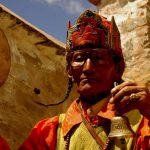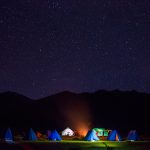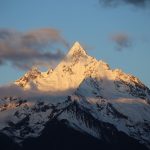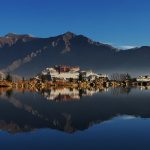Author Archives: Windhorse Admin
Tibetan Whitewater
Yak herders near Everest Base Camp are used to seeing crazy foreigners parading around in strange climbing gear. But rarely had they seen something this bizarre – a trio of turtle-like figures with plastic shells on their backs, setting doggedly off from Everest Base Camp. As the herders watched, one of turtles fell over backwards and landed heavily on its ‘shell’, snapping the paddle attached to the back. An aluminium strip – taken from a backpack – and duct tape were used as a splint and the group plodded on.
They discovered that their first target, the East Rong River, was seriously unrunnable – it disappeared down a huge sinkhole in Rongbuk Glacier. So they opted instead to put in at a large lake, elevation 5,250m. ‘Paddling on the lake was quite intimidating,’ says expedition leader Chris Jones, ‘as seracs and boulders regularly fell into the water. The lake had quite a strong flow and we quickly found ourselves paddling short rapids through dirty grey ice and huge boulders.’ And here a peculiar kayaking obstacle emerged: the group was scared that the river might flow back under the ice – with no way out. So they had to paddle very, very carefully. The kayakers were also thankful they were wearing drysuits – the water was extremely cold, and falling in would have been a decidedly unnerving experience.
The trio of intrepid paddlers – Jones, Georgia LePlastrier and Justin Boocock – faced some hair-raising descents, with the river dropping through long boulder-strewn class V rapids (rapids are classed from I to VI, with the last involving ‘definite risk to life’). ‘Sometimes it was like riding a bobsled down a scree slope,’ says Jones. Despite that, the group eventually made it to Rongbuk Monastery, where they collapsed, exhausted.
‘The next day we paddled away from Rongbuk, with the entire community of monks and guesthouse staff watching from the banks,’ adds Jones. ‘The 20km below Rongbuk turned out to be wonderful, continuous class IV rapids with great views of Everest behind us. The river then eased up, but the gradient was so continuous we were clocking about 11kph. We paddled 60km that day and camped in an incredibly windy campsite.’
The day after, the trio covered around 60km, battling through a headwind to the village of Kharta on the east side of Everest, where the entire village crowded around their campsite. They were edging closer to the Nepalese border, and the Arun gorges, famous for their formidable canyons and unrunnable white water. Enough was enough. In three exhausting days, the group had completed a partial circuit of Everest by river. Their time on the water had been short but intense; a very satisfying exploratory foray, as Jones puts it.
Many of the subcontinent’s rivers – the Indus, Salween, Mekong, Yangtze, and Brahmaputra – have their sources in Tibet, rushing through deep gorges between towering snow-capped peaks.
The Everest of white water kayaking is the mighty Tsangpo Gorge – the deepest in the world. After the loss of two extreme kayakers, the river was written off as unrunnable. But, in 2002, seven of the world’s top kayakers launched into the wild water of the Upper Tsangpo – the most fearsome they said they had ever seen, with class V+ rapids, thundering past boiling eddies, great vertical drops, massive lateral waves and huge boulders. Alternatively paddling and portaging (carrying their boats) – and seal-launching from huge boulders – the team paddled about 90 per cent of the Upper Gorge, covering about 70km.
Just prior to his Everest foray, Jones led 12 world-class kayakers on the first descent of the Yigong Tsangpo, about two days’ drive northeast of Lhasa, encountering fearsome rapids up to class V. The team planned on a descent of 275km and had managed to paddle about 125km of it when they encountered a huge gorge. They asked local people about it, but were told that nobody really knew where it went and what sort of river conditions to expect. Without local knowledge or detailed maps, the team made the decision to retreat.
Jones and partner Sharyn Smith work for Wind Horse Adventure, the only rafting company in Tibet that offers regular trips from Lhasa. The company has run mountaineering, trekking and mountain-biking forays for many years and, when it decided to branch out into river-running, invited Jones and Smith to manage the operation. Clients range from first-time rafters to world-class kayakers on those making exploratory first descents. The company also employs three skilled Nepalese rafters and is training local Tibetans to take on roles on the water.
There are cultural taboos to overcome for Tibetan trainees, however. Fast-flowing rivers are normally regarded as places to avoid because they are associated with drowning, and there is hardly any tradition of pleasure boating, or of recreational swimming in the country, not least because the waters there are often extremely cold. Tibetans also do not fish – a taboo linked to their Buddhist beliefs – and the boatmen who ply traditional yak-skin coracles at river crossings are seen as belonging to a relatively low stratum of society. Language is also a problem for Tibetan trainees, with English proving hard to learn. Their Mandarin, however, is likely to be better and that bodes well for dealing with a growing number of Chinese customers. Not that this is always an easy job. Jones says he has encountered something of a macho culture among some Chinese paddlers, who, he adds, have been known to refuse to listen to mandatory safety instructions before getting into a raft and heading downstream.
Perhaps more damaging to Tibet’s nascent rafting and kayaking tourism could be China’s insatiable hunger for electricity. The country’s engineers have been eyeing Tibet’s pristine rivers for hydroelectric projects. At least a dozen large-scale plans are on the drawing board for Tibet. Jones warns that such dams have the potential to destroy rafting in the country almost before it has started. Michael Buckley is author of Tibet: The Bradt Travel Guide (Bradt, £13.99/$27), and Heartlands: Travels in the Tibetan World (Summerdale Travel, £7.99/$16).
Paddling on the Roof of the World
Rafting Tibet
Rafting the Druksum Chu
Photo courtesy of Chris Jones
Shangri-la, the land of snows, the roof of the world, a high altitude desert: from most descriptions of Tibet it is hard to believe that Tibet is home to a large number of spectacular rivers. Mt Kailash in the west of Tibet is the source of the subcontinents four greatest rivers: the Ganges, Indus, Sutlej and Bramaputra. In the east, the forested land of Kham is home to the source of the Mekong and the Yangtse, the two largest rivers in east Asia. In the summer months regular rains swell Tibet’s rivers and the result is a surprising number of world class rafting and kayaking rivers.
Tibetans have used rivers for transport for hundreds of years. Yak skin coracles ferried passengers and goods regularly across the Yarlung Tsangpo and the Lhasa river. Modern river running in Tibet began in the early eighties when intrepid kayakers and rafters began to explore Tibet’s rivers. However, due to travel restrictions and challenging logistics, very little river exploration has been conducted. Boating in Tibet used to be the domain of the high budget expedition or the clandestine dirtbag mission. However, Tibet has now begun to open up. New roads and modern vehicles have made river access easier and river permits are now somewhat easier to procure. The result is an amazing number of world-class rivers just waiting to be explored.
In the summer of 2003 the stars aligned and I was fortunate to get the opportunity to help a Tibetan adventure travel company establish the first Tibet-based river guiding outfit. On the first of July I flew in to Lhasa loaded with 80kg of boating gear. I had no idea what to expect. My first task was to begin training Tibet’s first river guides. I had four trainees who were raring to go but had limited river skills (and questionable swimming skills!) As you can imagine, the first few days of training were fairly amusing. Luckily the boys learned quickly. Three experienced Nepali guides drove up from Katmandu and we quickly formed a multi-cultural team communicating in English, Nepali and our feeble attempts at Tibetan. We conducted much of our introductory training in an outdoor pool in Lhasa. Surrounded by groups of Tibetan and Chinese kids we taught the Tibetans the fundamentals of rafting and kayaking before we moved onto more challenging whitewater.
“No superlatives can really capture the size and power of these rapids. We estimated an approximate 150,000 cfs was thundering through the gorge…”
Over the next six weeks we paddled eight different rivers and creeks, some were first descents while others had been done once or twice before. Within a day’s drive of Lhasa there is an amazingly diverse selection of rivers. The Kyi Chu (Lhasa River) runs right through Lhasa and offers many miles of scenic, easy whitewater. One hour out of Lhasa is the Tolung Chu. This glacial fed run starts as a high altitude stream near amazing hot springs and plunges through a tight gorge before easing up to a friendly class 2/3 run. The higher you go the harder it gets and it can all be road scouted. Northeast of Lhasa is my favorite run. Situated in the stunning Drigung Valley we found 60km of crystal clear, high-altitude river. The upper sections offer class 5 creeking but the lower section offers two days of wonderfully continuous class 3 and 4. Nomads and yaks watched us at the put-in and high above the river to the north, vultures circled a traditional sky-burial site. Before or after the river trip a visit to the Terdom Nunnery and the sublime hot springs is a must.
Further east of Lhasa we paddled a three-day trip on the Kongpo Chu. Once again we started on a high altitude alpine stream that quickly built in volume and turned into a superb class 3/4 run. Towards the end of the second day we encountered a gorge that has four huge rapids. After an hour and a half of scouting and nervous debate, we ran the gorge, perfecting the art of HUGE volume class 5 boating: Stay near the bank and whatever you do, DO NOT get flushed into the center of the river!!
We were having quite a wet season. In Lhasa it rained every single day in July. We had been waiting for the rain to stop so we could get on the Yarlung Tsangpo. Everything we had heard about this river made it sounds like the hardest run in the world, but our maps and old expedition reports indicated we could find some runnable sections. Towards the end of August we finally gave up waiting for the high waters to go down and figured we should go check it out.
Where the Kyi Chu meets the Yarlung the river looks like the Mississippi; flat, muddy and very wide. However, as we drove towards Shigatse the nature of the river changes. The river banks close in and a huge gorge forms near the town of Nyemo. We scouted as much as we could. The rapids were huge. From the road we thought we could see lines but as we pulled out the binoculars and got closer to the river we realized the true size of the rapids. No superlatives can really capture the size and power of these rapids. We estimated an approximate 150,000 cfs was thundering through the gorge and locals told us the river was running unseasonably high for this time of year. We wisely drove out of the gorge with the boats firmly strapped to the roof. Perhaps next season the water will be lower!
We headed closer to Shigatse and found somewhat tamer water. A far cry from the alpine rivers we had been running for the past few weeks, the Yarlung here was still a powerful monster of a river. The huge waves dwarfed our kayaks and made our 14ft raft look like a bathtub toy. It felt more like sea kayaking then whitewater boating! The river was moving so fast it only took us just over three hours to paddle just under 50km!
September came around far too quickly and I had to meet commitments back in Canada. My two months in Tibet were, by far, the most unique paddling adventure I have ever undertaken. On our final night in Lhasa the Tibetan trainees took us out on the town to celebrate their success and my departure. We had already run ten commercial trips and two of the guys could now roll and paddle class 3 water. With a hazy head I flew out of Lhasa the next morning. My flight path took me out over the wild forested regions of eastern Tibet. Even from 30,000 feet I could see multitudes of rivers cascading through the forests just waiting to be explored and paddled.
Postscript
An international group of kayakers is planning to complete the first descent of the remote and wild Yigong Tsangpo River in central Tibet. Lead by Australian kayaker, Chris Jones, the team of professional kayakers and photographers includes Australian freestyle paddler Georgia LePlastrier, Australian Olympic hopeful, Justin Boocock and English freestyle and extreme paddler, Ed Cornfield. The team meets in Katmandu on 27th April to begin the arduous four day drive through the Himalaya to Lhasa, the capital of Tibet. The Yigong Tsangpo is another two days drive north of Lhasa.
The team hopes to navigate the entire length of the river from its source on the Tibetan Plateau, 275km to its confluence with the Po Tsangpo. The middle section of the river is expected to provide the biggest challenge with 140km of remote and challenging whitewater. The team expects to find class 4 and 5 whitewater and is preparing for up to 3 weeks on the water. A support crew will hike the rough terrain along the river-bank, restocking the kayakerÕs supplies and providing a safety back up. After the completion of the river the team will spend up to one month exploring other rivers and helping train the first Tibetan river guides.
The expedition is currently supported by www.kokatat.com, www.tibetwindhorse.com, www.liquidlogickayaks.com, www.teva.com, www.wildequipment.com.au, www.northwater.com, www.FNAheadgear.com, www.adventurepro.com.au, www.wernerpaddles.com.
Reting Tsangpo Expedition: First Full Descent
Custom East Tibet Kayak Expedition Report
Here is his story:
Ever since beeing a kid I was deeply astonished and touched by the magical place Tibet, by its beautiful, mysterious landscape, its cultural heritage and more imporantly its past, present and future with the Chinese influence. So as Mariann Saether got in contact with me in August with the question if I want to join a trip to the roof of the World, it didn’t take me a second to confirm my intention to join them. The next weeks and months were spent with all kinds of things, two events to organise, managing that Olympic champion, etc.. yet the date of departure came fastly closer and the excitement was rising at same speed every single day.
The whole team arrived together in Lhasa on a warm November afternoon. Surprised by the unexpected warmth. The team used the first few days to get used to the extended height of 4000 meters, in order to be able to paddle within our abilties with enough oxygen in our lungs. We did visit the Potala Palace as well as some other cultural treasures, yet after 4 days the whole team was ready to leave!
On the first day we had to drive over 2 passes, which were both over 5000 meters high, in order to reach our first piece of Tibetan whitewater. We were welcomed with 2 days of rain, which were the only ones on our whole trip, though!
Our mission was to head to the Parlung Tsangpo area, warm-up on some tributaries then run more or less the whole length of Parlung Tsangpo as well as the entrance to the mighty Po Tsangpo gorges (which finally forms the Yarlung Tsangpo).
Yet first we were still getting used to the high altitude as well as the considerably larger volume than in our home countries, to be ready to run the gnar and meat on the upcoming big volume runs.
We experienced beautiful whitewater and a scenery which was just mindblowing!
The Swiss members of the team were lucky enough to get a sweet deal on Palm products.., dry gear, which was much needed in the very cold, fast and continous whitewaters of Chile! Marc Gacond, a wellknown Raft Guide was outfitted with a Sidewinder DrySuit and couldnt believe the comfort and easiness of that piece of gear… (told you! ;))
Since we were a big group, there were a few issues appearing, especially on how to travel and experience Tibet. Yet in the end, we were able to talk about it and find solutions…
After a day hiking, where we went up to the very source of the Parlung Tsangpo… What we discovered was no less than mindblowing… Nature of such beauty, majesty and pureness that all of group that took the hike went back with a heart full of emotions!
The following days we were back on the water… moving down the Parlung… 200kms of wicked whitewater lay ahead of us…. growing bigger every single mile..
In the end we entered the Po Tsangpo, a mighty river with huge rapids in between flat stretches… The Swiss crew wanted to take on the last big one, but unfourtenatly the waterlevel dropped too much the last days and left a white hell to an already very intimidating rapid! After a short hike out, we were on the way back to Lhasa, were the majority of the team left straight away! We stayed another 4-5days, unable to boat but with plenty of options to entertain ourselves!
A huge thanks goes out to Tibet Wind Horse Adventure, Chris Jones and Jed Weingarten. WIthout these guys our trip would have been much less pleasant! If you ever consider to head to Tibet (u should!!) make sure to drop these guys a mail, they will sort you out with anything!
After a short stay in Bejjing, we headed back to Switzerland where Mark hit straight the cutting room. And while you read this, Gilette World Sports is broadcasting a big segment of it, all around the world! If you have the chance to check out Gilette World Sports this month.. we guess it will be well worth it!
So what stays with us are unforgetable moments of a living and astonishing Tibetian culture, beautiful nature, a spirit within Tibet which is almost unbelievable and memories of some of the most beautiful whitewater we have ever paddled on!
Thanks goes out to VW Multivan for making this trip possible and PALM for supporting us with awesome and dry gear as well as all the other brands, which did have a part to make this happen!!
Hope to see you soon on a river
Simon Hirter





